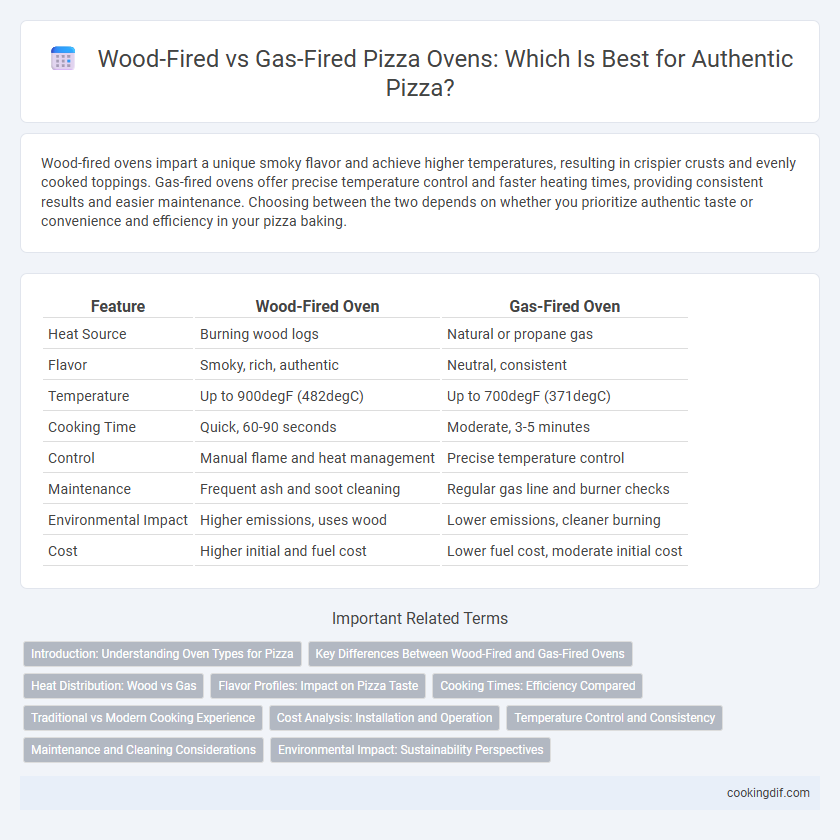Wood-fired ovens impart a unique smoky flavor and achieve higher temperatures, resulting in crispier crusts and evenly cooked toppings. Gas-fired ovens offer precise temperature control and faster heating times, providing consistent results and easier maintenance. Choosing between the two depends on whether you prioritize authentic taste or convenience and efficiency in your pizza baking.
Table of Comparison
| Feature | Wood-Fired Oven | Gas-Fired Oven |
|---|---|---|
| Heat Source | Burning wood logs | Natural or propane gas |
| Flavor | Smoky, rich, authentic | Neutral, consistent |
| Temperature | Up to 900degF (482degC) | Up to 700degF (371degC) |
| Cooking Time | Quick, 60-90 seconds | Moderate, 3-5 minutes |
| Control | Manual flame and heat management | Precise temperature control |
| Maintenance | Frequent ash and soot cleaning | Regular gas line and burner checks |
| Environmental Impact | Higher emissions, uses wood | Lower emissions, cleaner burning |
| Cost | Higher initial and fuel cost | Lower fuel cost, moderate initial cost |
Introduction: Understanding Oven Types for Pizza
Wood-fired ovens create intense heat exceeding 900degF, imparting a distinct smoky flavor and crispy crust prized in traditional Neapolitan pizzas. Gas-fired ovens offer precise temperature control and consistent heat distribution, ideal for replicating authentic pizza cooking in commercial settings. Selecting the right oven impacts cooking time, flavor profile, and crust texture, shaping the overall pizza experience.
Key Differences Between Wood-Fired and Gas-Fired Ovens
Wood-fired ovens reach temperatures of 800degF to 900degF, creating a unique smoky flavor and a crisp, charred crust that gas-fired ovens typically cannot replicate. Gas-fired ovens offer more precise temperature control and faster heat-up times, enabling consistent cooking with less maintenance. The choice between wood-fired and gas-fired ovens impacts flavor profile, cooking speed, and operational convenience.
Heat Distribution: Wood vs Gas
Wood-fired ovens provide uneven heat distribution with intense hot spots that enhance the crust's char and smoky flavor, ideal for Neapolitan-style pizzas. Gas-fired ovens offer more consistent and controllable heat, ensuring even cooking and precise temperature management for uniform crust and toppings. The choice between wood and gas impacts the pizza's texture, flavor complexity, and cooking time due to their distinct heat distribution methods.
Flavor Profiles: Impact on Pizza Taste
Wood-fired ovens impart a smoky, charred flavor that enhances the complexity of pizza crusts and toppings, creating a crispy texture with subtle earthy undertones. Gas-fired ovens provide consistent, even heat, resulting in a more uniform bake but with less pronounced smokiness and depth. The wood fire's natural aromatic compounds contribute significantly to the traditional Neapolitan pizza taste, distinguishing it from the cleaner, milder flavor produced by gas-fired ovens.
Cooking Times: Efficiency Compared
Wood-fired ovens reach higher temperatures, often between 700-900degF, allowing pizzas to cook in just 90-120 seconds, which enhances crust texture and flavor through rapid heat exposure. Gas-fired ovens generally operate at lower temperatures, around 500-700degF, requiring 3-5 minutes to cook pizzas, offering more consistent temperature control and less smoke. The faster cooking time of wood-fired ovens promotes a distinctive char and crispy exterior, while gas-fired ovens provide efficiency and ease of use for steady, predictable cooking results.
Traditional vs Modern Cooking Experience
Wood-fired ovens deliver an authentic, smoky flavor with high, uneven heat that enhances the traditional Neapolitan pizza texture and crispiness. Gas-fired ovens offer precise temperature control and consistent heat distribution, catering to modern cooking efficiency and uniform results. Both oven types influence pizza taste and cooking style, balancing heritage with contemporary convenience.
Cost Analysis: Installation and Operation
Wood-fired pizza ovens typically involve higher initial installation costs due to the need for specialized refractory materials and chimney systems, while gas-fired ovens offer lower upfront expenses with simpler setup requirements. Operational costs for wood-fired ovens include purchasing wood, maintenance of ash removal, and chimney cleaning, leading to variable expenses depending on wood quality and availability. Gas-fired ovens benefit from consistent, controllable fuel costs and lower maintenance, making them more cost-effective for high-volume commercial use.
Temperature Control and Consistency
Wood-fired ovens offer intense heat reaching up to 900degF, creating a unique smoky flavor and crisp crust, but temperature control can be challenging due to fluctuating heat levels. Gas-fired ovens provide precise temperature regulation with consistent heat distribution, ensuring uniform cooking and predictable results. Chefs favor wood-fired ovens for traditional, artisanal qualities while gas ovens are preferred for efficiency and consistent output in high-volume settings.
Maintenance and Cleaning Considerations
Wood-fired pizza ovens require frequent cleaning to remove ash and soot buildup, demanding regular maintenance to preserve optimal heat performance. Gas-fired ovens offer easier maintenance with fewer residues, requiring primarily occasional cleaning of burners and vents to ensure consistent gas flow. Both oven types benefit from scheduled inspections, but gas-fired models generally cost less time and effort in upkeep compared to wood-fired alternatives.
Environmental Impact: Sustainability Perspectives
Wood-fired pizza ovens release particulate matter and carbon monoxide, contributing to local air pollution, but use renewable biomass as fuel, offering a carbon-neutral advantage if sourced sustainably. Gas-fired ovens produce fewer particulates and greenhouse gases per cooking cycle, leveraging natural gas or propane which burn cleaner but rely on fossil fuels with a higher overall carbon footprint. Evaluating sustainability, wood-fired ovens support circular bioeconomy principles, while gas-fired ovens provide efficiency with lower immediate emissions yet depend on non-renewable energy sources.
Wood-fired vs Gas-fired for oven type Infographic

 cookingdif.com
cookingdif.com